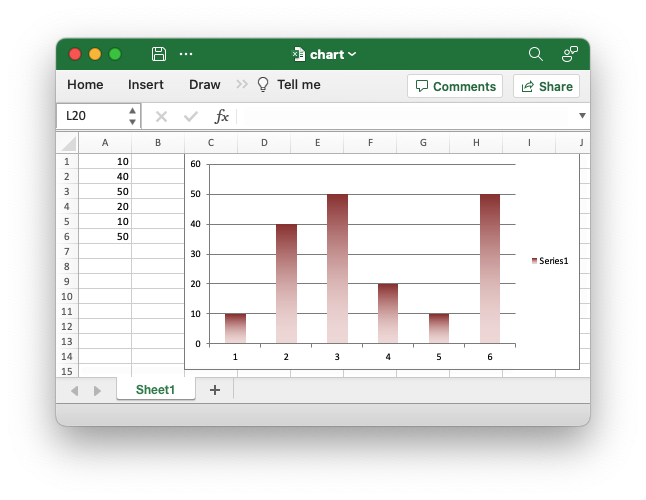Chart: Gradient Fill: Example of a chart with Gradient Fill
A example of creating column charts with fill gradients using the
ChartFormat and ChartGradientFill structs.
Image of the output file:

Code to generate the output file:
// SPDX-License-Identifier: MIT OR Apache-2.0
//
// Copyright 2022-2025, John McNamara, jmcnamara@cpan.org
//! An example of creating a chart with gradient fills using the `rust_xlsxwriter`
//! library.
use rust_xlsxwriter::{
Chart, ChartGradientFill, ChartGradientStop, ChartType, Format, Workbook, XlsxError,
};
fn main() -> Result<(), XlsxError> {
let mut workbook = Workbook::new();
let worksheet = workbook.add_worksheet();
let bold = Format::new().set_bold();
// Add the worksheet data that the charts will refer to.
worksheet.write_with_format(0, 0, "Number", &bold)?;
worksheet.write_with_format(0, 1, "Batch 1", &bold)?;
worksheet.write_with_format(0, 2, "Batch 2", &bold)?;
let data = [
[2, 3, 4, 5, 6, 7],
[10, 40, 50, 20, 10, 50],
[30, 60, 70, 50, 40, 30],
];
for (col_num, col_data) in data.iter().enumerate() {
for (row_num, row_data) in col_data.iter().enumerate() {
worksheet.write(row_num as u32 + 1, col_num as u16, *row_data)?;
}
}
// Create a new column chart.
let mut chart = Chart::new(ChartType::Column);
//
// Create a gradient profile to the first series.
//
chart
.add_series()
.set_categories("Sheet1!$A$2:$A$7")
.set_values("Sheet1!$B$2:$B$7")
.set_name("Sheet1!$B$1")
.set_format(ChartGradientFill::new().set_gradient_stops(&[
ChartGradientStop::new("#963735", 0),
ChartGradientStop::new("#F1DCDB", 100),
]));
//
// Create a gradient profile to the second series.
//
chart
.add_series()
.set_categories("Sheet1!$A$2:$A$7")
.set_values("Sheet1!$C$2:$C$7")
.set_name("Sheet1!$C$1")
.set_format(ChartGradientFill::new().set_gradient_stops(&[
ChartGradientStop::new("#E36C0A", 0),
ChartGradientStop::new("#FCEADA", 100),
]));
//
// Create a gradient profile and add it to chart plot area.
//
chart
.plot_area()
.set_format(ChartGradientFill::new().set_gradient_stops(&[
ChartGradientStop::new("#FFEFD1", 0),
ChartGradientStop::new("#F0EBD5", 50),
ChartGradientStop::new("#B69F66", 100),
]));
// Add some axis labels.
chart.x_axis().set_name("Test number");
chart.y_axis().set_name("Sample length (mm)");
// Turn off the chart legend.
chart.legend().set_hidden();
// Add the chart to the worksheet.
worksheet.insert_chart_with_offset(0, 3, &chart, 25, 10)?;
workbook.save("chart_gradient.xlsx")?;
Ok(())
}